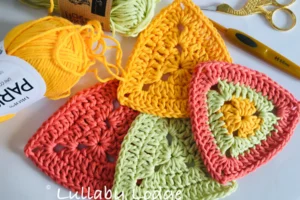Master how to crochet solid triangles with easy step-by-step instructions, pattern variations, and ideas to use them in stylish projects.
Anúncios
Crochet solid triangles are simple yet powerful building blocks in the world of handmade creations.
Whether you’re crafting bunting, shawls, blankets, or geometric designs, solid triangles offer endless versatility.
These triangles are quick to make, easy to customize, and serve as a great foundation for larger, creative projects.
They can be joined together to form hexagons, chevrons, or even used as decorative edging.
For beginners and experienced crocheters alike, learning how to make a solid triangle adds a valuable technique to your toolkit.
In this article, you’ll discover how to crochet solid triangles, tips for perfecting the shape, and creative ways to use them.
We’ll also share free pattern ideas, video tutorials, and inspiration for colorful and functional projects.
What Is a Crochet Solid Triangle?
A crochet solid triangle is a three-sided shape created using basic stitches with no open spaces between rows.
Unlike lace or mesh triangle patterns, solid triangles are dense and structured.
They provide stability and warmth, making them ideal for items like coasters, blankets, and garment inserts.
These triangles can be worked from the top down, bottom up, or from the center outward.
They can be symmetrical (equilateral) or asymmetrical depending on your increase method and stitch count.
Most commonly, solid triangles are worked in rows with consistent increases at both ends and in the middle.
This creates a neat triangle with straight sides and a defined peak.

Materials Needed to Crochet Solid Triangles
Before you begin, gather the essential materials for crocheting solid triangles.
1. Yarn
Choose a yarn suitable for your intended project.
Worsted weight yarn is ideal for practicing or making home items like blankets.
Cotton yarn works well for coasters or decorative motifs.
Use acrylic yarn for durability in wearables and accessories.
Pastel, gradient, or bold colors can all be used to add personality to each triangle.
2. Crochet Hook
Use the hook size recommended for your yarn.
Generally, a 4.0 mm to 5.5 mm hook works well with medium-weight yarn.
A smaller hook will result in tighter, more compact triangles.
Larger hooks create looser, softer triangles with more drape.
3. Stitch Markers
Optional but helpful when tracking increases or corner stitches.
Markers help ensure consistent shaping row by row.
4. Scissors and Yarn Needle
Use scissors for cutting yarn and a yarn needle for weaving in ends.
A blunt needle is best for sewing triangle edges together when joining pieces.
How to Crochet a Basic Solid Triangle
Here is a beginner-friendly method for crocheting a symmetrical solid triangle using double crochet stitches.
Step 1: Foundation
Begin with a slip knot and chain 4.
Work 3 double crochets into the first chain to create your base row.
This forms a small triangle tip and sets up the foundation for increases.
Step 2: Row Two
Chain 3 and turn your work.
Make 2 double crochets into the first stitch.
Make 1 double crochet in the next stitch.
Work 2 double crochets into the last stitch.
Now you have 5 double crochets in row two.
This is the basic structure: increase at each end to grow the triangle evenly.
Step 3: Continue Rows
Repeat the increase pattern in each row.
Chain 3 at the beginning of each new row to serve as your first stitch.
Always add 2 double crochets in the first and last stitches of each row.
Crochet 1 double crochet in every stitch in between.
As you continue, your triangle will grow in width and height proportionally.
You can stop when it reaches the size you want or follow a pattern with a specific stitch count.
Step 4: Fasten Off and Weave Ends
Once your triangle is the desired size, fasten off by cutting the yarn and pulling through the last loop.
Use your yarn needle to weave in any loose ends neatly.
Blocking your triangle can help straighten edges and improve the shape.
Alternate Techniques for Solid Triangles
There are a few ways to make solid triangles beyond the standard row method.
1. From the Center Out
This method starts at the center of the triangle and works outward in rounds.
You begin with a magic ring or chain ring and increase at three points to form the triangle shape.
This technique is great for making equilateral triangle motifs for shawls or mandalas.
Increases are made at the center of each side, forming three distinct points.
2. Granny Style Solid Triangle
Granny triangles mimic the structure of granny squares, but without gaps.
They often involve clusters of double crochets and are worked from the tip downward.
These triangles grow quickly and look great in multi-color yarns.
Granny-style triangles are perfect for boho or retro projects.
3. Corner-to-Corner (C2C) Triangle
Using the C2C method, you can create diagonal solid triangles.
This involves working half a square using the traditional C2C technique.
C2C triangles are great for geometric afghans and modern-looking designs.
Tips for Perfect Solid Triangles
Use these helpful tips to improve consistency and quality in your triangle projects.
1. Count Your Stitches
Always count your stitches at the end of each row to maintain symmetry.
A missed or extra stitch can distort the triangle’s shape.
2. Watch Your Edges
Crocheting into the turning chain can create uneven edges if not done carefully.
Try placing a stitch marker in your turning chain to make it easier to find.
3. Block Your Triangles
Use steam or wet blocking to straighten and shape your triangles for a polished finish.
Pin the triangle to a board and let it dry to set its form.
4. Use Matching Yarn for Joining
If you plan to join triangles together, use the same color or a complementary shade.
This keeps the project cohesive and visually appealing.
Creative Projects Using Crochet Solid Triangles
Solid triangles can be used in countless ways beyond standalone motifs.
Here are some ideas to inspire your next project.
1. Triangle Bunting
Make colorful triangles and string them together for party or seasonal decor.
Use different colors for each triangle to match holidays or events.
Add tassels or pompoms at each point for extra flair.
This is a quick and satisfying beginner-friendly project.
2. Triangle Shawls and Wraps
Work one large triangle with increasing rows for a stylish shawl.
Add fringe along the edges or crochet a lacy border for elegance.
Use soft yarns like cotton blends or alpaca for comfort.
This is a fashionable and functional accessory for all seasons.
3. Blankets and Throws
Combine multiple triangles to form diamonds, squares, or chevron patterns.
Join triangles edge to edge using whip stitch or slip stitch.
Alternate colors for a vibrant, eye-catching blanket.
Use heavier yarns for warmth or lighter yarns for a decorative throw.
4. Crochet Bags and Pouches
Join triangles into hexagons or larger geometric shapes and sew into a pouch.
Add a zipper or drawstring for functionality.
Use bold color blocking to create a modern, stylish accessory.
5. Wearables and Embellishments
Use solid triangles as inserts in tops, dresses, or sleeves.
Sew them into fabric garments for added texture and handmade charm.
They also work well as pocket flaps, appliqués, or patches.
Free Crochet Solid Triangle Patterns and Tutorials
Here are some free resources and video tutorials to help you get started.
-
Simple Solid Triangle by Yarnspirations – A basic written pattern using double crochet rows.
-
Granny Triangle Video by Bella Coco – Step-by-step video for making neat triangle motifs.
-
C2C Triangle Tutorial by Fiber Spider – Shows how to make diagonal half-square triangles.
-
Solid Triangle Shawl by Make and Do Crew – A full-size shawl pattern that starts with a triangle base.
-
Mandala Triangle Pattern by Moogly Blog – A decorative center-out triangle motif for home decor.
These tutorials will help you master shaping, increasing, and finishing techniques.
Crochet solid triangles are versatile, easy to learn, and full of creative potential.
Whether you make them as simple motifs or building blocks for larger pieces, their usefulness is undeniable.
By learning a few techniques and trying different applications, you can create home decor, accessories, and gifts.
The projects you can create with solid triangles are limited only by your imagination.
They are an excellent way to practice stitch consistency, explore color combinations, and build confidence.
So grab your yarn and hook, and start experimenting with the endless possibilities of crochet solid triangles.
With every triangle, you’re one stitch closer to creating something beautiful.




